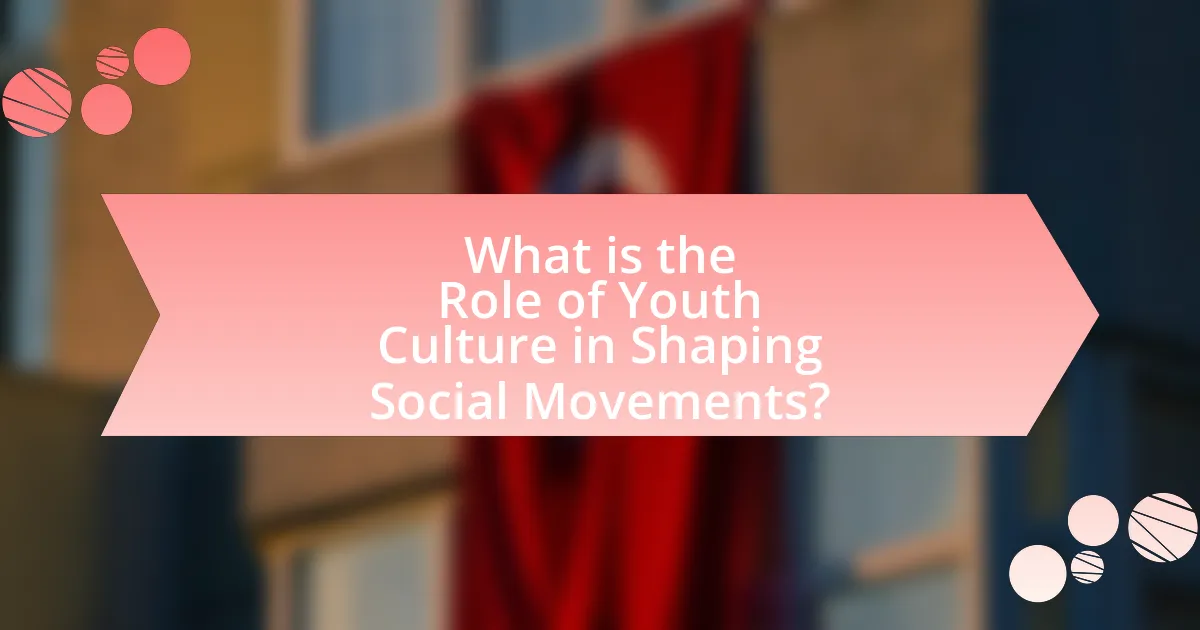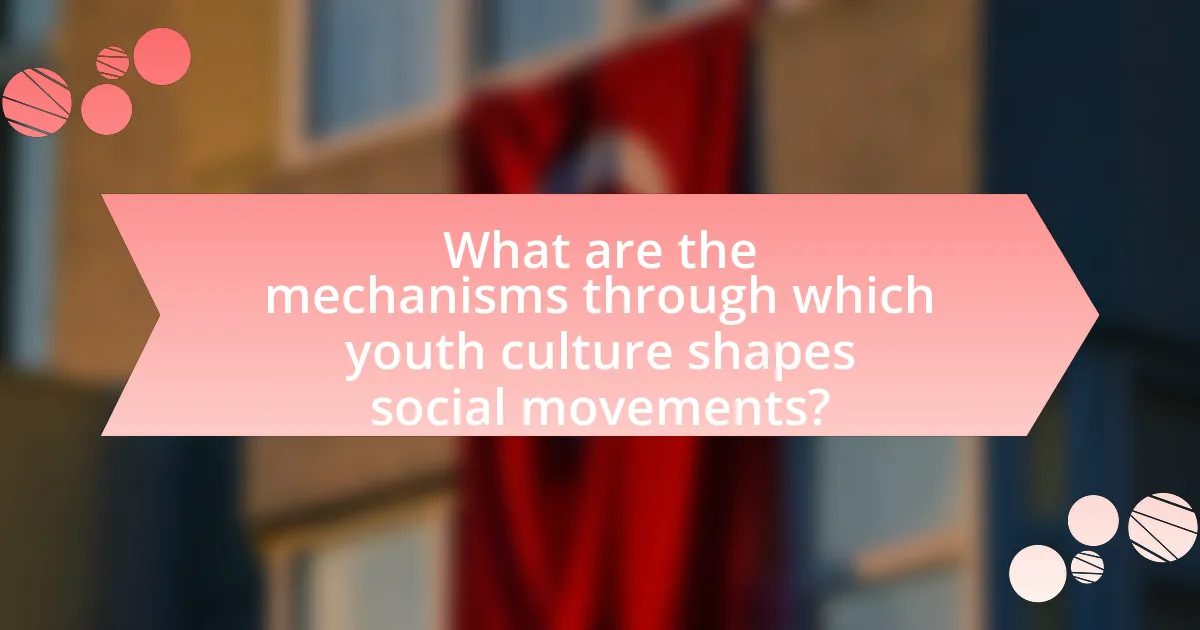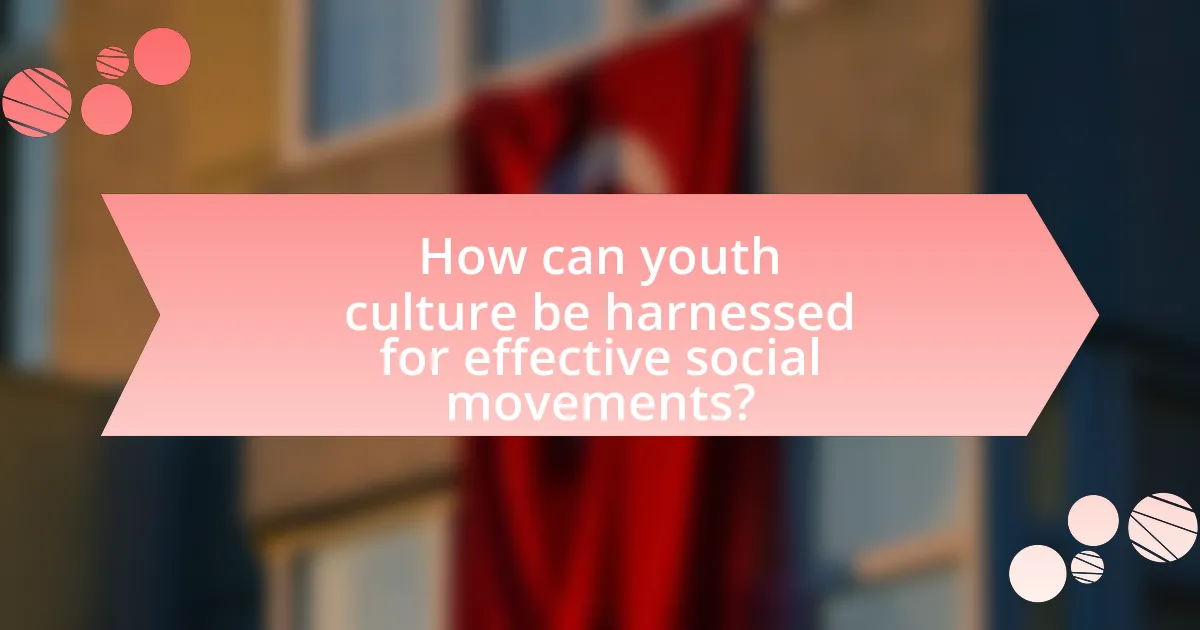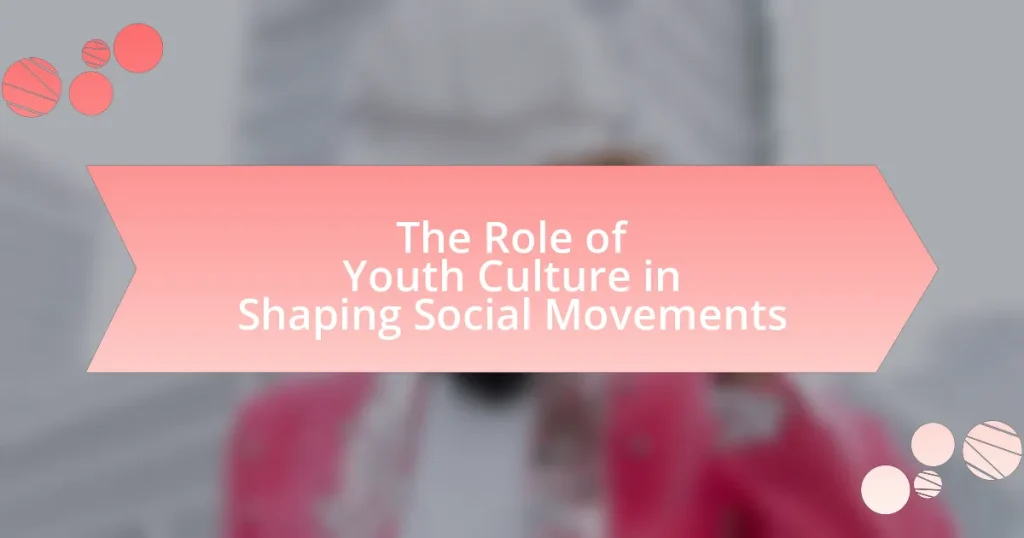Youth culture plays a pivotal role in shaping social movements by driving innovation, mobilizing participants, and influencing public discourse. Historically, young activists have been at the forefront of significant social changes, such as the civil rights movement and contemporary movements like Black Lives Matter and climate activism. Key characteristics of youth culture, including a strong sense of identity and the effective use of digital platforms, empower young people to challenge societal norms and advocate for transformative change. The article explores the mechanisms through which youth culture influences social movements, the impact of social media, and the challenges faced by young activists, while also highlighting historical examples and strategies for enhancing youth participation in activism.

What is the Role of Youth Culture in Shaping Social Movements?
Youth culture plays a crucial role in shaping social movements by driving innovation, mobilizing participants, and influencing public discourse. Historically, youth have been at the forefront of significant social changes, such as the civil rights movement in the 1960s, where young activists organized protests and advocated for equality, demonstrating their capacity to challenge societal norms. Additionally, contemporary movements like Black Lives Matter and climate activism, led by figures such as Greta Thunberg, showcase how youth leverage social media to amplify their messages and engage a global audience. This generational engagement not only fosters solidarity among diverse groups but also brings fresh perspectives that can reshape traditional activism, making youth culture a vital force in contemporary social movements.
How does youth culture influence social change?
Youth culture significantly influences social change by acting as a catalyst for new ideas and movements. Young people often challenge existing norms and values, leading to shifts in societal perspectives. For instance, the civil rights movement in the 1960s saw youth actively participating in protests and advocating for equality, which helped to reshape public opinion and policy. Additionally, contemporary movements like climate activism, led by figures such as Greta Thunberg, demonstrate how youth mobilization can drive global awareness and action on pressing issues. This influence is further evidenced by the rise of social media, where youth culture disseminates information rapidly, amplifying voices and fostering collective action.
What are the key characteristics of youth culture that drive social movements?
Key characteristics of youth culture that drive social movements include a strong sense of identity, a desire for social change, and the use of digital platforms for communication and organization. Youth often seek to express their individuality and collective identity through activism, which is evident in movements like Black Lives Matter and climate activism led by figures such as Greta Thunberg. Additionally, the urgency for social change is fueled by issues like inequality, climate change, and systemic injustice, motivating young people to mobilize. The prevalence of social media allows for rapid dissemination of ideas and coordination of protests, exemplified by the Arab Spring and recent global climate strikes. These characteristics collectively empower youth to challenge the status quo and advocate for transformative societal changes.
How do social media and technology amplify youth voices in movements?
Social media and technology amplify youth voices in movements by providing platforms for rapid communication, organization, and visibility. These digital tools enable young activists to share their messages widely, mobilize supporters, and engage in real-time discussions. For instance, during the Black Lives Matter movement, hashtags like #BlackLivesMatter gained millions of mentions on Twitter, allowing youth to raise awareness and influence public discourse on racial justice. Additionally, platforms like Instagram and TikTok have facilitated creative expression through videos and art, further enhancing the reach and impact of youth-led initiatives. Research shows that 70% of young people believe social media is essential for activism, highlighting its role in empowering youth to participate in social change.
Why is youth engagement crucial in social movements?
Youth engagement is crucial in social movements because it brings fresh perspectives, energy, and innovative ideas that can drive change. Young people often challenge the status quo and are more willing to adopt new methods of activism, as evidenced by movements like the global climate strikes initiated by youth activists such as Greta Thunberg, which mobilized millions worldwide. Furthermore, research indicates that youth participation can significantly increase the reach and impact of social movements, as seen in the 2011 Arab Spring, where young people utilized social media to organize protests and spread awareness rapidly. This active involvement not only empowers youth but also ensures that their voices and concerns are represented in the broader societal discourse.
What historical examples illustrate the impact of youth in social movements?
Youth have played a pivotal role in social movements throughout history, significantly influencing change. For instance, during the Civil Rights Movement in the United States, young activists like the Student Nonviolent Coordinating Committee (SNCC) organized sit-ins and freedom rides, which were crucial in challenging segregation laws. Their efforts led to the passage of the Civil Rights Act of 1964, demonstrating the power of youth in advocating for social justice.
Another example is the anti-Vietnam War movement in the 1960s, where college students mobilized protests against U.S. involvement in Vietnam. The widespread demonstrations, particularly the Kent State shootings in 1970, galvanized public opinion and contributed to the eventual withdrawal of American troops from Vietnam.
Additionally, the 2011 Arab Spring saw youth-led movements across the Middle East and North Africa, where young people utilized social media to organize protests against oppressive regimes. This collective action resulted in significant political changes in countries like Tunisia and Egypt, showcasing the impact of youth in shaping political landscapes.
These historical examples illustrate that youth have been instrumental in driving social movements, often leading to substantial legislative and societal changes.
How do youth perspectives differ from older generations in activism?
Youth perspectives in activism often emphasize immediate action and digital engagement, contrasting with older generations who may prioritize traditional methods and gradual change. For instance, youth activists frequently utilize social media platforms to mobilize support quickly, as seen in movements like Black Lives Matter, which gained traction through viral online campaigns. In contrast, older generations may rely on established institutions and face-to-face organizing, reflecting a belief in more conventional forms of advocacy. This generational divide highlights differing approaches to urgency and technology in social movements, with youth advocating for rapid responses to pressing issues such as climate change and social justice.

What are the mechanisms through which youth culture shapes social movements?
Youth culture shapes social movements through mechanisms such as identity formation, collective action, and the use of digital platforms. Identity formation occurs as young people develop shared values and beliefs, which fosters a sense of belonging and motivates them to engage in activism. Collective action is facilitated by youth’s ability to mobilize quickly around issues, often leading to organized protests and campaigns. The use of digital platforms, particularly social media, enables rapid dissemination of information and coordination of efforts, amplifying their voices and reaching wider audiences. For instance, the Arab Spring demonstrated how youth utilized social media to organize protests, leading to significant political changes in several countries.
How do cultural expressions contribute to activism?
Cultural expressions significantly contribute to activism by providing a platform for marginalized voices and fostering community engagement. Through art, music, literature, and performance, cultural expressions can raise awareness about social issues, mobilize support, and inspire action. For instance, the protest songs of the 1960s, such as Bob Dylan’s “The Times They Are a-Changin’,” galvanized public sentiment during the civil rights movement, illustrating how music can serve as a rallying cry for change. Additionally, visual art, like the murals created during the Chicano civil rights movement, visually communicated the struggles and aspirations of the community, making complex issues accessible and relatable. These cultural forms not only document social injustices but also create a shared identity among activists, enhancing solidarity and collective action.
What role do music and art play in mobilizing youth for social causes?
Music and art serve as powerful tools for mobilizing youth for social causes by fostering emotional connections and facilitating collective identity. These creative expressions resonate with young people, often reflecting their experiences and aspirations, which can inspire action and engagement. For instance, protest songs like “Fight the Power” by Public Enemy have historically galvanized youth movements, encouraging activism against social injustices. Additionally, visual art, such as murals and street art, often conveys messages of resistance and hope, making complex social issues more accessible and relatable. Research indicates that youth who engage with music and art related to social causes are more likely to participate in activism, as these mediums create a sense of community and shared purpose, ultimately driving social change.
How do fashion and lifestyle choices reflect and influence social movements?
Fashion and lifestyle choices serve as both reflections and influencers of social movements by embodying the values and identities of those involved. For instance, the punk movement of the 1970s utilized distinctive clothing styles, such as leather jackets and ripped jeans, to challenge societal norms and express rebellion against mainstream culture. This visual representation galvanized youth and communicated a collective identity, thereby influencing broader societal perceptions and discussions around issues like anti-establishment sentiments. Additionally, contemporary movements like Black Lives Matter have seen participants adopt specific fashion items, such as “I Can’t Breathe” shirts, to raise awareness and solidarity, demonstrating how clothing can amplify messages and mobilize communities. These examples illustrate that fashion and lifestyle choices not only reflect the ethos of social movements but also actively shape their narratives and impact.
What are the challenges faced by youth in social movements?
Youth in social movements face several challenges, including lack of resources, limited access to decision-making processes, and generational divides. These challenges hinder their ability to mobilize effectively and influence change. For instance, many young activists struggle with inadequate funding and support, which can limit their outreach and impact. Additionally, youth often encounter resistance from older generations who may not fully understand or support their perspectives, creating barriers to collaboration. Furthermore, the digital divide can restrict access to information and communication tools, essential for organizing and raising awareness. These factors collectively impede the effectiveness of youth-led initiatives in social movements.
How do societal perceptions of youth affect their activism?
Societal perceptions of youth significantly influence their activism by shaping the legitimacy and visibility of their voices. When society views young people as capable and informed, it encourages their participation in social movements, as seen in the global climate strikes led by youth activists like Greta Thunberg, which gained widespread media attention and support. Conversely, negative perceptions, such as viewing youth as irresponsible or uninformed, can marginalize their efforts and diminish their impact. Research indicates that youth-led movements often face skepticism, which can hinder their ability to mobilize support and resources, as highlighted in the study “Youth Activism in the 21st Century” by the University of California, Berkeley. This dynamic illustrates how societal attitudes can either empower or constrain youth activism, ultimately affecting the outcomes of social movements.
What barriers do young activists encounter in their efforts?
Young activists encounter several barriers in their efforts, including lack of funding, limited access to decision-making platforms, and generational divides in communication. Funding constraints often hinder their ability to organize events or campaigns effectively, as many rely on small donations or volunteer efforts. Limited access to decision-making platforms restricts their influence in policy discussions, as established leaders may overlook or dismiss their contributions. Additionally, generational divides can create communication challenges, where older generations may not fully understand or support the innovative approaches young activists employ. These barriers collectively impede the effectiveness and reach of youth-led social movements.

How can youth culture be harnessed for effective social movements?
Youth culture can be harnessed for effective social movements by leveraging its unique characteristics, such as creativity, digital fluency, and a strong sense of community. These attributes enable young people to mobilize quickly, spread awareness through social media platforms, and engage in innovative forms of activism. For instance, the 2019 climate strikes, led by youth activists like Greta Thunberg, demonstrated how young people can galvanize global attention and action on pressing issues by utilizing social media to organize and amplify their message. This approach not only raises awareness but also fosters a sense of belonging and collective action among participants, making youth culture a powerful tool for driving social change.
What strategies can enhance youth participation in social movements?
To enhance youth participation in social movements, strategies such as leveraging social media platforms, fostering community engagement, and providing educational resources are effective. Social media platforms like Instagram and TikTok allow for rapid dissemination of information and mobilization of youth, evidenced by movements like Black Lives Matter, which gained significant traction through online campaigns. Community engagement initiatives, such as local workshops and events, create spaces for youth to voice their concerns and collaborate on solutions, as seen in various grassroots organizations that successfully involve young people in activism. Additionally, educational resources that inform youth about social issues and activism techniques empower them to take action, supported by studies indicating that informed youth are more likely to participate in civic activities.
How can organizations better engage with youth culture?
Organizations can better engage with youth culture by leveraging digital platforms and social media to create authentic connections. Research indicates that 95% of teenagers have access to a smartphone, making these platforms essential for reaching this demographic. By utilizing interactive content, such as polls, challenges, and user-generated content, organizations can foster participation and dialogue. Additionally, collaborating with youth influencers who resonate with their audience can enhance credibility and relatability. A study by the Pew Research Center found that 72% of teens feel more connected to brands that engage with them on social media, highlighting the importance of genuine interaction in building relationships with youth culture.
What role do educational institutions play in fostering youth activism?
Educational institutions play a crucial role in fostering youth activism by providing a platform for critical thinking, civic engagement, and social awareness. These institutions often incorporate curricula that emphasize social justice, history of activism, and the importance of community involvement, which equips students with the knowledge and skills necessary to advocate for change. For instance, programs like debate clubs, student government, and service-learning initiatives encourage students to engage with societal issues actively. Research indicates that students involved in such programs are more likely to participate in activism, as evidenced by a study from the Center for Information & Research on Civic Learning and Engagement, which found that high school students who engage in civic education are significantly more likely to vote and participate in community service. Thus, educational institutions not only educate but also empower youth to become active participants in social movements.
What best practices can be adopted for successful youth-led movements?
Successful youth-led movements can adopt best practices such as fostering inclusivity, leveraging social media for outreach, and building coalitions with established organizations. Inclusivity ensures diverse voices are heard, which enhances the movement’s legitimacy and reach; for instance, the Black Lives Matter movement effectively included various demographics to amplify its message. Utilizing social media platforms allows for rapid dissemination of information and mobilization of supporters, as seen in the global response to climate change led by youth activists like Greta Thunberg. Additionally, forming coalitions with established organizations can provide resources and credibility, exemplified by youth groups partnering with NGOs to strengthen their initiatives. These practices contribute to the effectiveness and sustainability of youth-led movements.
How can collaboration between youth and established organizations be improved?
Collaboration between youth and established organizations can be improved by creating structured mentorship programs that facilitate knowledge exchange and skill development. These programs can provide young individuals with access to resources, networks, and expertise that established organizations possess, while allowing organizations to gain fresh perspectives and innovative ideas from youth. Research indicates that mentorship can enhance engagement and retention in social movements, as seen in studies like “The Impact of Mentorship on Youth Development” by the National Mentoring Partnership, which highlights that youth involved in mentorship programs are more likely to participate in civic activities.
What lessons can be learned from successful youth-led movements?
Successful youth-led movements demonstrate the importance of grassroots organization and the power of collective action. These movements often mobilize large numbers of young people who are passionate about social change, as seen in the 2019 climate strikes initiated by Greta Thunberg, which engaged millions globally. Additionally, successful youth-led movements highlight the effectiveness of leveraging social media for outreach and engagement, exemplified by the Black Lives Matter movement, which utilized platforms like Twitter and Instagram to amplify their message and organize protests. Furthermore, these movements teach the value of intersectionality, as they often address multiple social issues simultaneously, fostering a more inclusive approach to activism.
